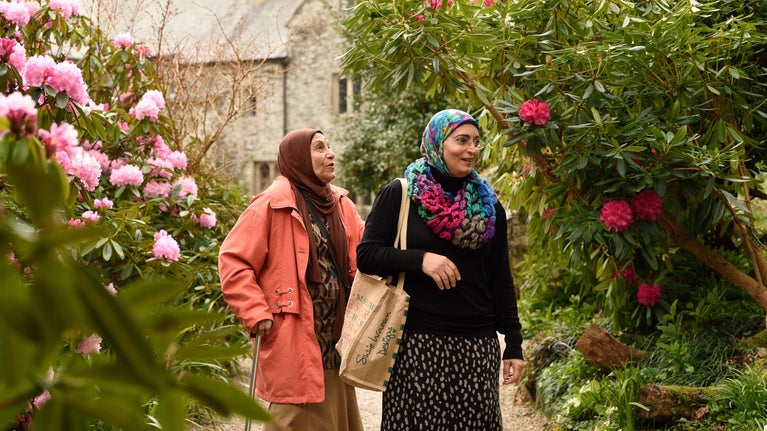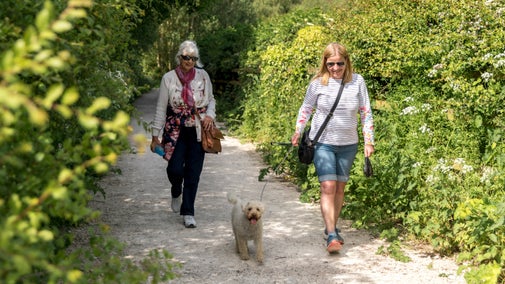
Discover more at Cotehele
Find out when Cotehele is open, how to get here, the things to see and do and more.

Spring is a dazzling time to visit Cotehele, as the estate comes alive with daffodils. Cotehele is fortunate to be home to a variety of daffodils and there’s a real history behind these sunny flowers on the estate and the wider Tamar valley. Some of the daffodil varieties at Cotehele date back to the 17th century. Visit in the spring to celebrate this beautiful flower and learn more about the fascinating heritage.
The daffodil display at Cotehele for this year is now over. Join us next year when they start to appear between mid-February and April.
Daffodils start to emerge from mid-February, signalling the imminent arrival of spring, and continue to flower through into May. Different varieties take centre stage at different times.
The sunny plants flower all over the estate, but can particularly be found across from the Barn Cafe, in the meadow behind the house, in the Old Orchard and at the centurary orchard near Cotehele Quay.
If you’re visiting with your dog, please be aware that some of the daffodils are in some areas of the garden which are dog-free. Please ensure a member of your party is able to remain with your dog outside these areas. Areas of the garden; such as the orchards, remain dog-free to allow us to protect the biodiversity in these areas.
Daffodils are a welcome sight after a long winter, with the first glimpse of bright yellow reminding us that spring is on its way
Cotehele estate holds a variety of daffodils, ranging from tiny multi-flowered Tête-à-Têtes, which often appear early in the season, to the ruffled petals of the so-called Butter and Eggs. There’s so much diversity in the colour, petal shape and size.
Many of the seedlings are supplied by local daffodil grower Dan du Plessis, but some varieties date to the 17th century. Most are 19th-century hybrids, the surviving remnants of a major flower industry that once thrived along the Tamar valley.

The Tamar Valley has been home to daffodil growing for centuries. The warm, wet climate and steep, south-facing banks of the river catch the early spring sunshine, meaning crops arrive earlier than the rest of the country.
In the past, smallholders grew fruit, flowers and vegetables in small plots known as market gardens. Early daffodil varieties included Golden Harvest and Fortune. Bulbs were planted by hand and the flowers were picked and packed for sale by local families and communities.
We are particularly proud of our collection; it pays tribute to the heritage of the Tamar Valley while showing off nature at her finest.

When the railway was extended into Cornwall in the 19th century, the market garden industry boomed, with daffodils at centre stage. Daffodils had long been packed onto barges, like the Shamrock, and sailed down the River Tamar to be sold at Devonport Market.
However, the new railway link meant the daffodils could be distributed around the country. At the industry’s peak, as many as 10,000 people were employed to pick and pack daffodils.
The Tamar Valley became famous for its rare and interesting varieties. This included the indigenous Tamar Double White, which produced beautiful, fragrant flowers late in the season. These were sent to Covent Garden individually in blue tissue-lined boxes.
Everything changed during the Second World War. Daffodil market gardens made way for food crops to help support the war effort. The daffodil bulbs were lifted and planted into the nearby hedgerows.
The daffodil industry may have declined, but the bright flowers still burst from the hedgerows and countryside each spring. It’s a vivid reminder of the valley’s heritage.

Find out when Cotehele is open, how to get here, the things to see and do and more.
Take a stroll around the 5.5 hectares of Cotehele's garden where you’ll discover terraced herbaceous borders, a lily pond as well as a medieval stewpond and dovecote.

There's lots to discover at the Cotehele estate. Miles of pathways lead you through ancient woodland, past a historic chapel, and to an important Victorian quay.

Tuck into a cream tea at one of Cotehele’s cafés, find an eco-friendly gift or plant at the shop, and discover local artists at The Bull Pen Gallery.

Dogs are welcome to join you at Cotehele. There are miles of paths and loads of space where they can stretch their legs and bowls of clean water once they’re thirsty. Cotehele is a two pawprint rated place.
